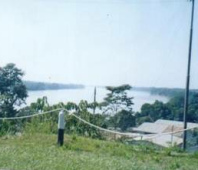from: Dilwyn Jenkins: The
rough guide to Peru; Rough Guides, New York, London,
Delhi; 6th edition September 2006; www.roughguides.com
Puerto Maldonado founded by
Fitzcarrald
Madre de Dios [department] is centered on the fast-growing
river town of Puerto Maldonado, near the Bolivian border,
supposedly founded by legendary explorer and rubber baron
Fitzcarrald. The town, which extends a tenuous political and
economic hold over the vast department, has a fast-growing
population of over 30,000. The streets are laid out in rigid
grid pattern, not emanating from a central plaza as in most
Peruvian cities, but stretching out from the port and
Tambopata riverfront, towards the airport and forest edge.
These days it has (p.541)
a busy city center buzzing with motorbikes and chicha music.
The port area offers an otherwise rare glimpse of the river,
which is largely shielded from view by the ever-growing rows
of wooden houses and lumber yards. The main avenue, León
Velarde, combines the usual bars and restaurants with pool
halls, hammock shops and offices. The feel you get here is
of a rapidly growing, but still intimate and small city,
whose young people spend endless evenings sitting row upon
row in front of the web-connected glare of computer
monitors, in hopes of procuring lucrative careers in the
future (p.542).
Puerto Maldonado: rigid grid
pattern
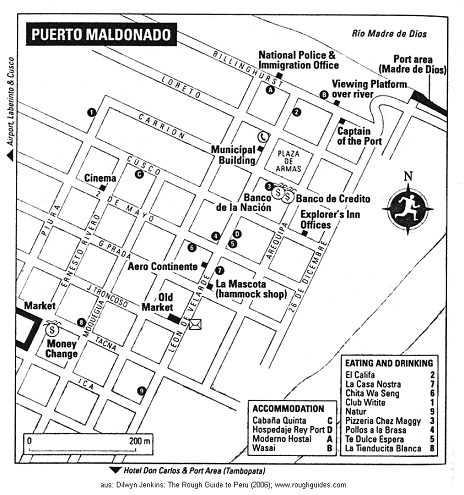
 Map
of
the center of Puerto Maldonado with it's grid
pattern and tourist indications Map
of
the center of Puerto Maldonado with it's grid
pattern and tourist indications |
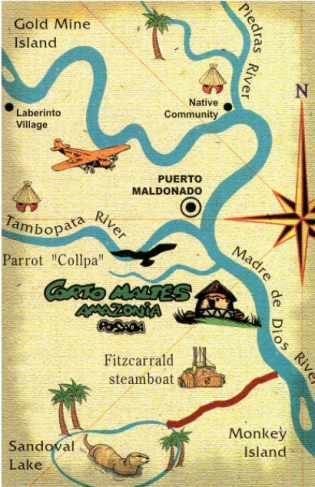
Map with the position of Puerto Maldonado with the
rivers Madre de Dios, Piedras, Tambopata and the
Sandoval Lake |
The saga of Fitzcarrald
Fitzcarrald (often mistakenly called Fitzcarraldo) is
associated with the founding of Puerto Maldonado, but he
actually died some twelve years before the event, though his
story is relevant to the development of this region. While
working rubber on the Río Urubamba, Fitzcarrald evidently
caught the gold bug after hearing rumours from local
Ashaninka and Machiguenga Indians of an Inca fort protecting
vast treasures, possibly around the Río Purus. Setting out
along the Mishagua, a tributary of the Río Urubamba, he
managed to reach its source, and from there walked over the
ridge to a new watershed which he took to be the Purus,
though it was in fact the Río Cashpajali, a tributary of the
Río Manu.
Leaving men to clear a path, he returned to Iquitos, and in
1884 came back to the region on a boat called
La Contamana. He took
the boat apart, and with the aid of over a thousand
Ashaninka and other Indians, carried it across to the
"Purus". But, as he cruised down, attacked by tribes at
several points, Fitzcarrald slowly began to realize that the
river was not the Purus - a fact confirmed when he
eventually bumped into a Bolivian rubber collector.
Though he'd ended up on the wrong river, Fitzcarrald had
discovered a link connecting the two great Amazonian
watershed. In Europe, the discovery was heralded as a great
step forward in the exploration of South America, but for
Peru it meant more rubber, a quicker route for its export,
and the beginning of the end for Madre de Dios' indigenous
tribes. Puerto Maldonado was founded in 1902, and as
exploitation of the region's rubber peaked, so too was there
an increase in population of workers and merchants, with
Madre de Dios ultimately becoming a department of Peru in
1912. German director Werner Herzog thought this historical
episode a fitting subject for celluloid, and in 1982
directed the epic
Fitzcarraldo.
History of Puerto
Maldonado: rubber - game hunters - timber exploitation -
oil and gold damage
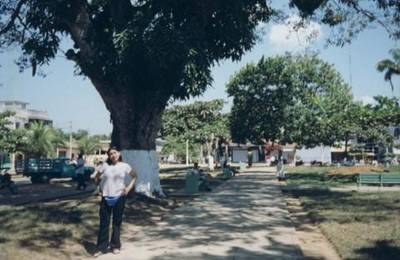
Alley in Puerto Maldonado
A remote settlement even for Perú, PUERTO MALDONADO is a
frontier colonist town with strong links to the Cusco region
and a great fervour [passion] for bubbly jungle
chicha music. With an
economy based on unsustainable gold extraction and highly
sustainable Brazil-nut gathering from the rivers and forests
of Madre de Dios, it has grown enormously over the last
twenty years from a small, laid-back outpost of civilization
to a busy market town. Today it's the thriving, safe (and
fairly expensive) capital of a region that feels very much
on the threshold [borderline] of major upheavals, with a
rapidly developing tourist industry.
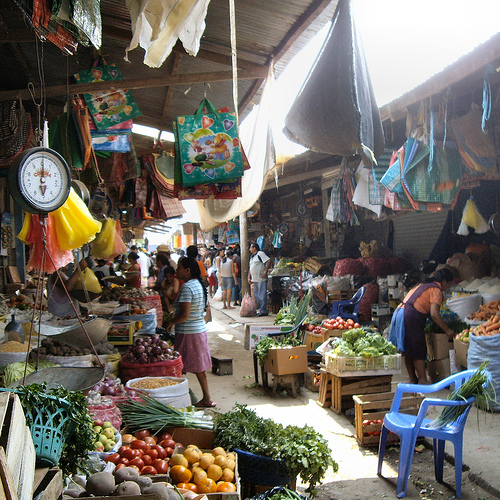
Market of Puerto Maldonado
Over a hundred years ago it was rubber that established
Puerto Maldonado at the beginning of the twentieth century.
During the 1920s came the game hunters, who dominated the
economy of the region, and after them, mainly in the 1960s,
the exploiters of mahagony and cedar trees arrived - leading
to the construction of Boca Manu airstrip, just before the
oil companies moved in during the 1970s. Whilst gold-mining
and logging [timber exploitation] - both mostly illegal
frontier businesses - keep the town buzzing today.
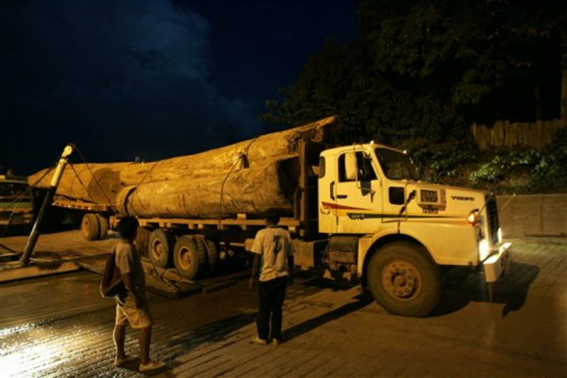
A truck (Volvo) with robbed wood from the rain forest is
crossing the river Madre de Dios near Puerto Maldonado
There is the question why truck firms like Volvo are
delivering trucks for the destruction of the rain forest.
The truck firms could stop the destruction of the rain
forest!
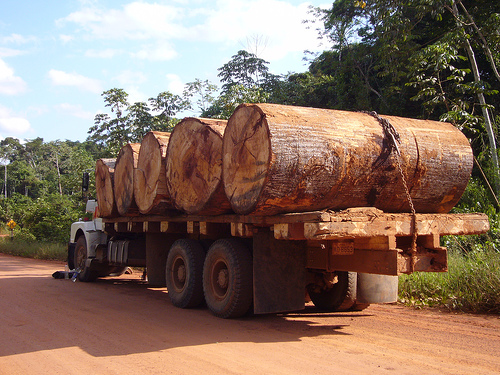
A truck with robbed wood from the rain forest on the road
between Iñapari and Puerto Maldonado
The truck firms could stop the destruction of the rain
forest!
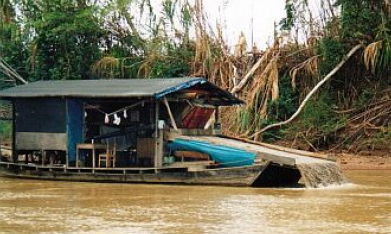
Gold floating dredge damaging heavily the riverbeds and
poisoning the river with mercury.
Most of the townspeople, riding coolly around on Honda
motorbikes, are second-generation
colonos,
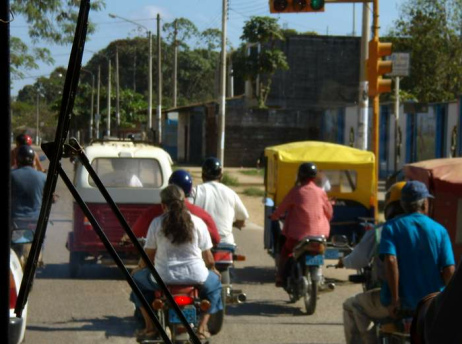
Puerto Maldonado, road with mototaxis and motorbikes
but there's a constant stream of new and hopeful arrivals -
rich and poor from all parts of South America, and even the
occasional gang from the US. The lure [seduction],
inevitably, is gold (p.544).
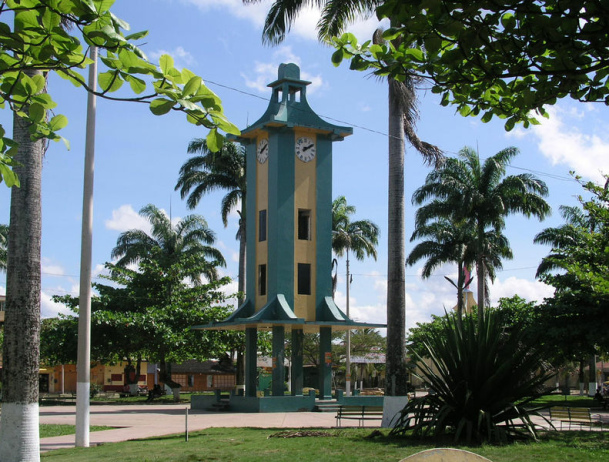
Puerto Maldonado, Plaza de Armas
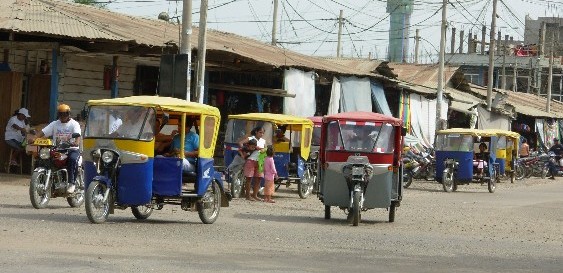
Motocars in Puerto Maldonado
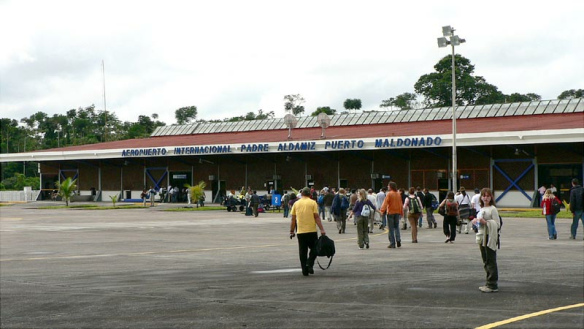
The entrance of the airport of Puerto Maldonado
If you arrive by plane, the blast of hot, humid air you get
the moment you step out onto the airport's runway is an
instant reminder that this is the Amazon Basin. Aero
Continente operate daily jets from Lima via Cusco, while
Aero Condor and Aero Santander offer cheaper, daily
propeller planes from Cusco (p.545).
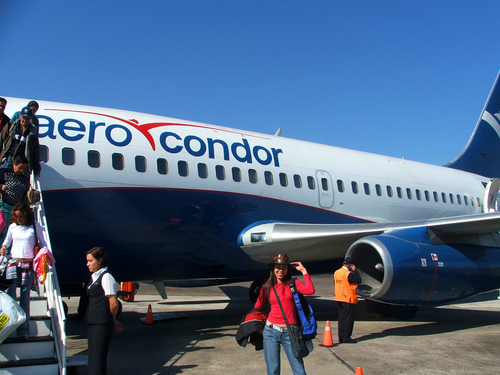
Airplane of Aero Condor for Puerto Maldonado
[The airline situation is changing every year, so ask at the
travel office].
Military Grupo Ocho [Group 8] planes also jet in from Cusco
several times weekly, but you need to check their schedule
at Cusco airport.
There are also two or three flights weekly to other jungle
destinations in Madre de Dios, such as Iberia; check with
travel agents or the new airline companies on arrival in
Peru (p.546).
Flights
-- from Puerto Maldonado to Cusco are several daily, a
flight of 1 hour
-- from Puerto Maldonado to Iberia are 2-3 weekly, a flight
of 30 min.
-- from Puerto Maldonado to Lima is daily, a flight of 2
hours
-- from Puerto Maldonado to Trujillo is daily, a flight of 2
hours (p.568).
Unless you're being picked up as part of an organized tour,
airport transfer is
simplest and coolest by motokar, costing around $2.50 for
the otherwise very hot eight-kilometer walk (p.546).
However you get here, you have to go through a yellow fever
vaccination checkpoint at Puerto Maldonado's small but
clean, modern and air-conditioned airport (T. 082-571533),
where there's also a tourist information kiosk
(www.regionmadrededios.gob.pe) and artesanía shops (p.547).
Arrival by bus or by truck
There are several buses from Cusco to Puerto Maldonado per
week. The trip needs 2 to 6 days (p.568).
Most of the trucks from Cusco arrive after a tough
500-kilometer journey at Puerto Maldonado main market on
Calle Ernesto Rivero, or block 19 of La Unión, also by the
market. It's a laborious, three- to ten-day journey down
from the glacial highlands [along the Río Inambari],
depending on how much it's raining; after passing into the
ceja de selva, the
muddy track winds its slippery way through dense tropical
vegetation, via the small settlement at Quincemil. The worst
period is generally between December and March (p.546).
Airlines in Puerto
Maldonado
Airlines TANS
[Jirón] León de Velarde 153
Grupo Ocho [Group 8]
[Jirón] Dos de Mayo,block 6 (no telephone).


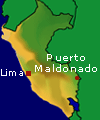
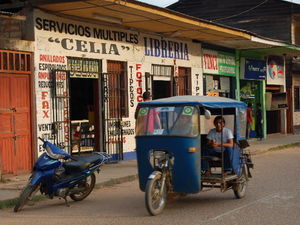
Map of the center of Puerto Maldonado with it's grid pattern and tourist indications

